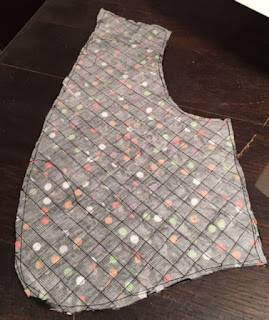Here we go.
Part 1 can be found here. But now it's time to cut and mark your pattern and start sewing.
I used Pellon's washaway stabilizer. You can use whatever brand you like as long as it will wash away when you're done. Be careful not to get it wet as you use it as it will disappear right before your very eyes.
For the tutorial, I am using a child's vest pattern, but the concept is the same no matter what size you use. Even if the vest says it's lined, you will not line it; you won't need to. If it is a lined pattern, take a little extra off the front center seam allowance as you will not be using it.
Place the front of your vest pattern on 2 layers of the stabilizer and cut it out.
Mark the right side of each piece (the marking will wash away and will not show). Make a line with a ruler on the front of the vest (right side). I chose a diagonal pattern. You can use horizontal and vertical, though. That choice is yours.
Decide how far apart you want your woven strips. For the child's size vest, I used a 1" wide ruler and followed the first line I drew, marking lines 1" apart.
Mark the stabilizer from top to bottom with your pencil and ruler.
Make a line in the other direction (again, I chose diagonal).
And make your 1" line markings all the way from top to bottom.
Repeat this process with the other front pattern piece, trying to match the diagonal lines where they meet in the center.
Now, let's weave!
Using the roll of strips that you made earlier, put the strip on or beside one of the lines you drew. Whether you choose to put it on the line or beside it, do it the same for every one. I chose beside the line for this one. Stitch from edge to edge onto the stabilizer. Turn and stitch back to the first edge. Pretend the stabilizer is not going to wash away and make sure your strip of fabric is firmly attached.
Place a second strip on or beside your next drawn line and repeat the process.
Stitch close to the edge of your strip. This particular fabric didn't show the stitching lines much, so I had the freedom of being a little less than perfect.
Continue until you have all strips going in one direction stitched to the stabilizer.
This is not a true weave per se, but it will look like it when done since the strips are of the same fabric. If they were different fabrics, I would have done over and under weaving. In this case, place a strip on or beside a line that is going the other way and stitch your fabric from end to end, turn and stitch again. This time, the two directions of stitching are more important because you're anchoring the strips to one another and not just the stabilizer.
When all of the strips are sewn (you can see my sewing lines here), turn the pattern over and stitch a scant 1/8" from the edge of the pattern all the way around using the stabilizer as your guide.
Here's the right side view.
And here's the wrong side view which also shows the edge stitching that holds the strips stable until the binding is done.
Trim excess fabric edges and set aside. Repeat with the other front pattern piece.
Looking like a vest front now, isn't it?
Using your favorite method, make bias binding out of the same fabric you are using for the vest back.
Cut out the vest back. Even if the pattern is lined, you will not line it, so you need to cut a little extra at the armhole and neck seam allowances.
Construct your vest by sewing the sides right side together and the shoulders right side together. Finish the seams however you like. I find that using your serger is a best practice, but you can also use pinking shears and press the seam open or press the seam to one side and stitch it down.
Apply bias binding by machine to the armholes by encasing the seam allowance in the bias tape you made. I generally start at the side seam and go around the armhole, careful not to stretch the binding too much. The rest of the bias binding will go around the remainder of the vest. I usually start at the neckline and take it all the way around, finishing at the neckline. You can machine stitch both sides or machine stitch one side and hand stitch the other (my preferred method for hiding of stitches).
When you are done, wash the vest. Trust me. You'll want to do this part to get rid of the stabilizer. Another way to do it is to spritz the wrong side of the front of the vest with water.
And you're done!
The addition of washaway stabilizer to my sewing room has opened up new design possibilities. You can use a real weave with over and under on strips or simply place them one upon the other like this vest. Once you encase the strips in bias binding, they're as stable as they can be and your vest is machine washable and able to be put in the dryer (if the fabric allows).
Have fun and be sure to share pictures if you make one for yourself or a child. Or even for your dog. Just sew. That's the big thing.
Let me know if you have questions!

































